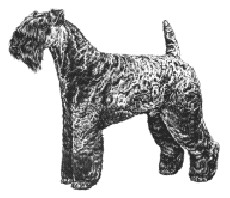Kerry Blue Terrier
General Information - Kerry Blue Terrier

Group:
Terrier
Size:
Medium
Lifespan:
12-15 years
Exercise:
Moderate
Grooming:
Very high
Trainability:
Very low
Watchdog Ability:
Very high
Protection Ability:
High
Area of Origin:
Ireland
Date of Origin:
1700s
Other Names:
Irish Blue Terrier
Original Function:
Ratting, badger
and fox hunting
History
The Kerry Blue Terrier originated in the 1700s in the mountainous regions of County Kerry from which its name is derived. The Kerry is the national terrier of Ireland (under the name Irish Blue Terrier) and has become a symbol of Ireland. The name comes from colour of the coat. No one knows for certain which breeds were used to develop the Kerry Blue, but many believe the Portuguese Water Dog contributed the silky, wavy single coat. Others think the Kerry Blue Terrier was developed from the old Black Terriers, Spanish (or Russian) 'Blue Dog', Soft Coated Wheaten Terrier and possibly Irish Wolfhounds and Irish Terriers. There is writing on dogs in Ireland over a century ago that mentions a Harlequin Terrier that sounds like a breed description of the Kerry Blue. Once groomed, the Kerry Blue is one of the most striking of all dogs. It has the peculiarity of being born black, the blue coloration not appearing until between nine months and two years of age. The Kerry Blue has been used as a small game hunter, retriever, herd and farm dog, house guardian, family companion, and even in police work. He can also be used to perform tricks. Today the Kerry Blue is primarily a companion and home guardian.
Temperament
Highly intelligent, determined and playful, Kerry Blue Terriers require firm handling as they may be dog-aggressive. It gets along splendidly with people and loves to be challenged. It can guard, hunt, herd or just be a fun-loving companion. It needs daily mental and physical activity in a safe area. It loves to run, chase, hunt, explore, play and dig. Indoors, it is well-mannered.
Upkeep
The Kerry Blue needs a good amount of exercise, but its needs can be met with a long walk on leash, a vigorous play session or a chance to explore off leash in a safe area. It can live outdoors in temperate climates, but it does better with access to the house. Its coat needs combing about twice a week, plus scissoring and coat shaping every month. Its ears may need to be taped when developing to ensure proper shape.
Kerry Blue Terrier
A breed standard is the guideline which describes the ideal characteristics, temperament, and appearance of a breed and ensures that the breed is fit for function with soundness essential. Breeders and judges should at all times be careful to avoid obvious conditions and exaggerations, as well as being mindful of features which could be detrimental in any way to the health, welfare or soundness of this breed.
Breed Standard - Kerry Blue Terrier
 Characteristics
Characteristics: Disciplined gameness. The Kerry Blue Terrier is a compact, powerful Terrier, showing gracefulness and an attitude of alert determination, with definite Terrier style and character throughout.
General Appearance: The typical Kerry Blue Terrier should be upstanding, well-knit and well proportioned, showing a well-developed and muscular body.
Head and Skull: Well balanced, long, proportionately lean, with slight stop and flat over the skull. Foreface and jaw very strong, deep and punishing; nose black; nostrils of due proportion.
Eyes: Dark as possible. Small to medium with keen Terrier expression.
Ears: Small to medium and V:shaped, carried forward but not as high as in some Terrier breeds.
Mouth: Teeth level with upper teeth just closing over the lower; dark gums and roof of mouth.
Neck: Strong and reachy, running into sloping shoulders.
Forequarters: Shoulders flat as possible with elbows carried close to the body while the dog is standing or in action. Legs straight, bone powerful. Front straight, neither too wide nor too narrow.
Body: Short coupled with good depth of brisket and well sprung ribs. Chest to be deep. Topline level.
Hindquarters: Large and well developed, stifle bent and hocks close to the ground giving perfect freedom of hind action.
Feet: Round and small. Toe-nails black.
Tail: Customarily docked. Set on high to complete a perfectly straight back and carried erect.
Coat: Soft and silky, plentiful and wavy
Colour: Any shade of blue, with or without black points. A shade of tan is permissible in puppies, as is also a dark colour up to the age of 18 months. A small white patch on chest should not be penalised.
Weight and Size: The most desirable weight for a fully:developed dog is from 14.9 to 16.7 kg (33 to 37 lb), and bitches should weigh proportionately less, but 15.8 kg (35 lb) is the most desirable weight to aim for. Ideal height - dogs 45.7 - 48.2 cm (18 - 19 in) at shoulder; bitches slightly less.
Faults: Hard or woolly coat. Solid black after 18 months. In excess of 48.2 cm (19 in) in height. Bumpy cheek bones, teeth undershot or very overshot. Rose ears. snipy foreface. Light-coloured or full eyes. Roach or hollowback. Close, stilted or cow-hocked hind action.
Note: Male animals should have two apparently normal testicles fully descended into the scrotum.
DNZ No 248
Copyright Dogs New Zealand
23 Dec 2013
Any departure from the foregoing points should be considered a fault and the seriousness with which the fault should be regarded should be in exact proportion to its degree and its effect upon the health and welfare of the dog and on the dog’s ability to perform its traditional work.




